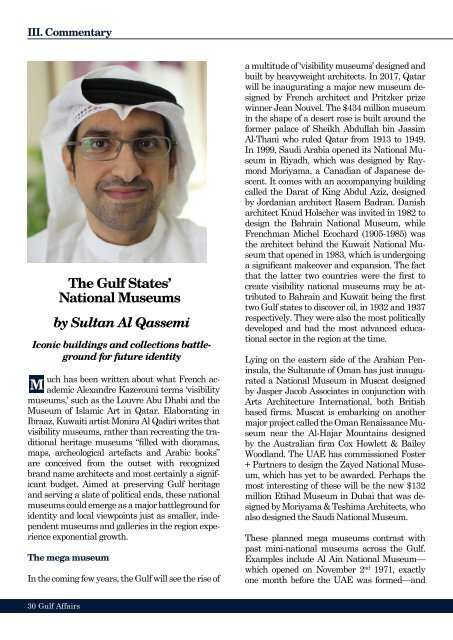You also want an ePaper? Increase the reach of your titles
YUMPU automatically turns print PDFs into web optimized ePapers that Google loves.
III. Commentary<br />
The Gulf States’<br />
National Museums<br />
by Sultan Al Qassemi<br />
Iconic buildings and collections battleground<br />
for future identity<br />
uch has been written about what French academic<br />
Alexandre Kazerouni terms ‘visibility<br />
museums,’ such as the Louvre Abu Dhabi and the<br />
Museum of Islamic Art in Qatar. Elaborating in<br />
Ibraaz, Kuwaiti artist Monira Al Qadiri writes that<br />
visibility museums, rather than recreating the traditional<br />
heritage museums “filled with dioramas,<br />
maps, archeological artefacts and Arabic books”<br />
are conceived from the outset with recognized<br />
brand name architects and most certainly a significant<br />
budget. Aimed at preserving Gulf heritage<br />
and serving a slate of political ends, these national<br />
museums could emerge as a major battleground for<br />
identity and local viewpoints just as smaller, independent<br />
museums and galleries in the region experience<br />
exponential growth.<br />
The mega museum<br />
In the coming few years, the Gulf will see the rise of<br />
a multitude of ‘visibility museums’ designed and<br />
built by heavyweight architects. In 2017, Qatar<br />
will be inaugurating a major new museum designed<br />
by French architect and Pritzker prize<br />
winner Jean Nouvel. The $434 million museum<br />
in the shape of a desert rose is built around the<br />
former palace of Sheikh Abdullah bin Jassim<br />
Al-Thani who ruled Qatar from 1913 to 1949.<br />
In 1999, Saudi Arabia opened its National Museum<br />
in Riyadh, which was designed by Raymond<br />
Moriyama, a Canadian of Japanese descent.<br />
It comes with an accompanying building<br />
called the Darat of King Abdul Aziz, designed<br />
by Jordanian architect Rasem Badran. Danish<br />
architect Knud Holscher was invited in 1982 to<br />
design the Bahrain National Museum, while<br />
Frenchman Michel Ecochard (1905-1985) was<br />
the architect behind the Kuwait National Museum<br />
that opened in 1983, which is undergoing<br />
a significant makeover and expansion. The fact<br />
that the latter two countries were the first to<br />
create visibility national museums may be attributed<br />
to Bahrain and Kuwait being the first<br />
two Gulf states to discover oil, in 1932 and 1937<br />
respectively. They were also the most politically<br />
developed and had the most advanced educational<br />
sector in the region at the time.<br />
Lying on the eastern side of the Arabian Peninsula,<br />
the Sultanate of Oman has just inaugurated<br />
a National Museum in Muscat designed<br />
by Jasper Jacob Associates in conjunction with<br />
Arts Architecture International, both British<br />
based firms. Muscat is embarking on another<br />
major project called the Oman Renaissance Museum<br />
near the Al-Hajar Mountains designed<br />
by the Australian firm Cox Howlett & Bailey<br />
Woodland. The UAE has commissioned Foster<br />
+ Partners to design the Zayed National Museum,<br />
which has yet to be awarded. Perhaps the<br />
most interesting of these will be the new $132<br />
million Etihad Museum in Dubai that was designed<br />
by Moriyama & Teshima Architects, who<br />
also designed the Saudi National Museum.<br />
These planned mega museums contrast with<br />
past mini-national museums across the Gulf.<br />
Examples include Al Ain National Museum—<br />
which opened on November 2 nd 1971, exactly<br />
one month before the UAE was formed—and<br />
30 Gulf Affairs


